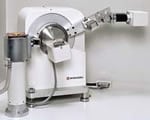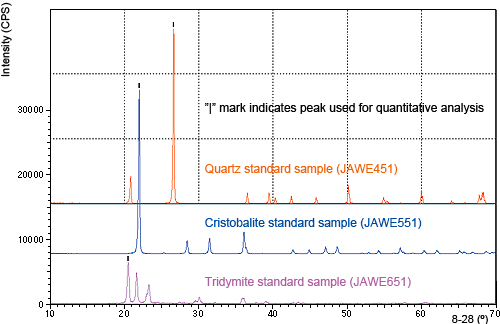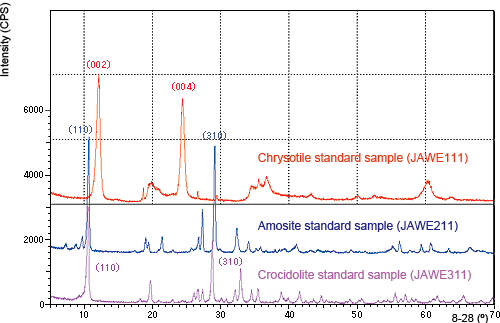LabX XRD-6100 - Features
X-ray Diffractometer
LabX XRD-6100 Features

- High speed and high precision vertical goniometer for various application
- Compact design of 900 mm (w) x 700 mm (d) x 1600 mm (h)
- Safety interlocked system. Door is locked during radiation
- Independent dual axis θ-2θ linkage drive, independent 2θ axis and θ axis drives are selectable.
- Various optional hardware and software
Qualitative and quantitative analysis of free silicic acids
The control concentration of mineral dust for working environment measurements is calculated using the following expression. (Revised on April 1, 2005. )
E = 3.0/(0.59Q + 1)(Reference) Pre-revision E = 2.9/(0.22Q + 1)
E: Control concentration mg/m3 Q: Free silicic acid content (%)
Consequently, it is important to know the content of free silicic acids in the dust. Free silicic acids may be present as quartz, cristobalite, or tridymite, etc.
This revision prescribes the use of an X-ray diffractometer to first identify the type of silicic acid (qualitative analysis). Based on these qualitative results, quantitation is performed using the phosphoric acid method or the base standard absorption correction method with an X-ray diffractometer.
The diagram below shows the diffraction patterns of free silicic acids. The type of free silicic acid can be easily identified from the characteristics of the pattern.
The diffraction X-ray intensity of the target substances must be corrected for the absorption of the matrix substance. This correction requires determination of the X-ray absorption coefficient of the matrix substance. The base standard absorption correction method can determine this from a single measurement. This package includes dedicated quantitative analysis software that incorporates the base standard absorption correction method.

Diffraction Patterns of Free Silicic Acids
Qualitative and quantitative analysis of asbestos
Asbestos Hazard Prevention Regulations were implemented in Japan in July 2005. Building materials and other samples subject to these regulations can be quantified by X-ray diffractometer using the standard addition method or internal standard addition method if the samples contain approximately 5 % or greater asbestos content by weight. If the asbestos content is below 5 %, however, quantitation may not be possible.
In this case, after conducting formic acid pretreatment to dissolve the sample matrix components, quantitation is performed by X-ray diffractometer using the base standard absorption correction method.
Such qualitative and quantitative analysis of asbestos can be performed using the XRD-6100 X-ray diffractometer environmental measurement package, which includes the environmental measurement stage for the base standard absorption correction method.

Diffraction Patterns of Types of Asbestos
The major types of asbestos are serpentine asbestos (chrysotile) and amphibole asbestos (amosite and crocidolite). The characteristic peaks of these types can be quantitatively analyzed by X-ray diffractometry.


